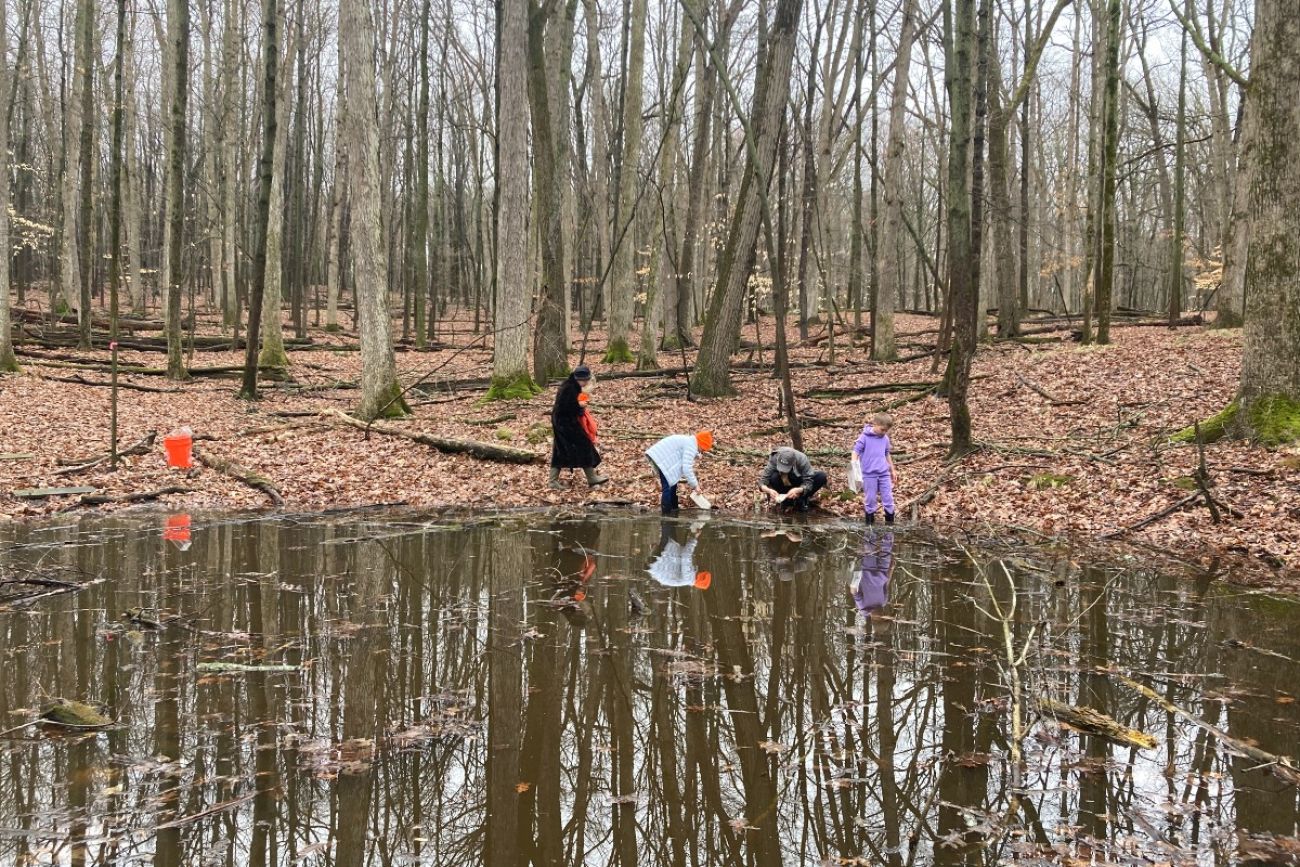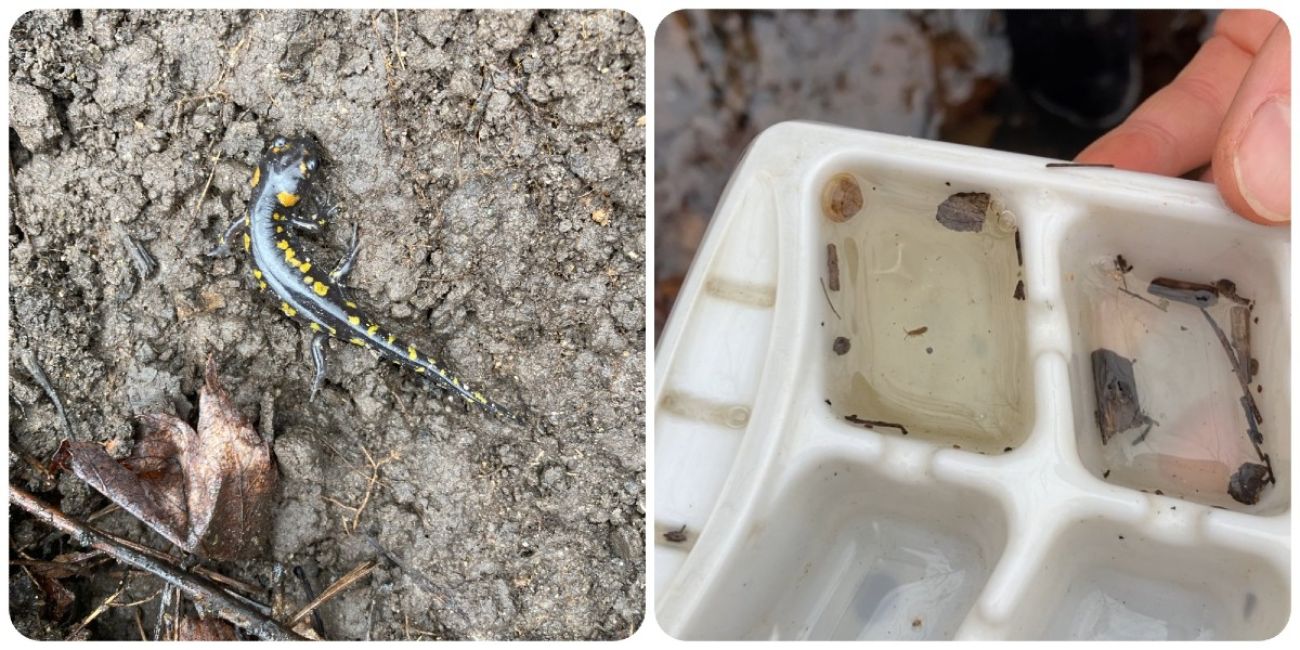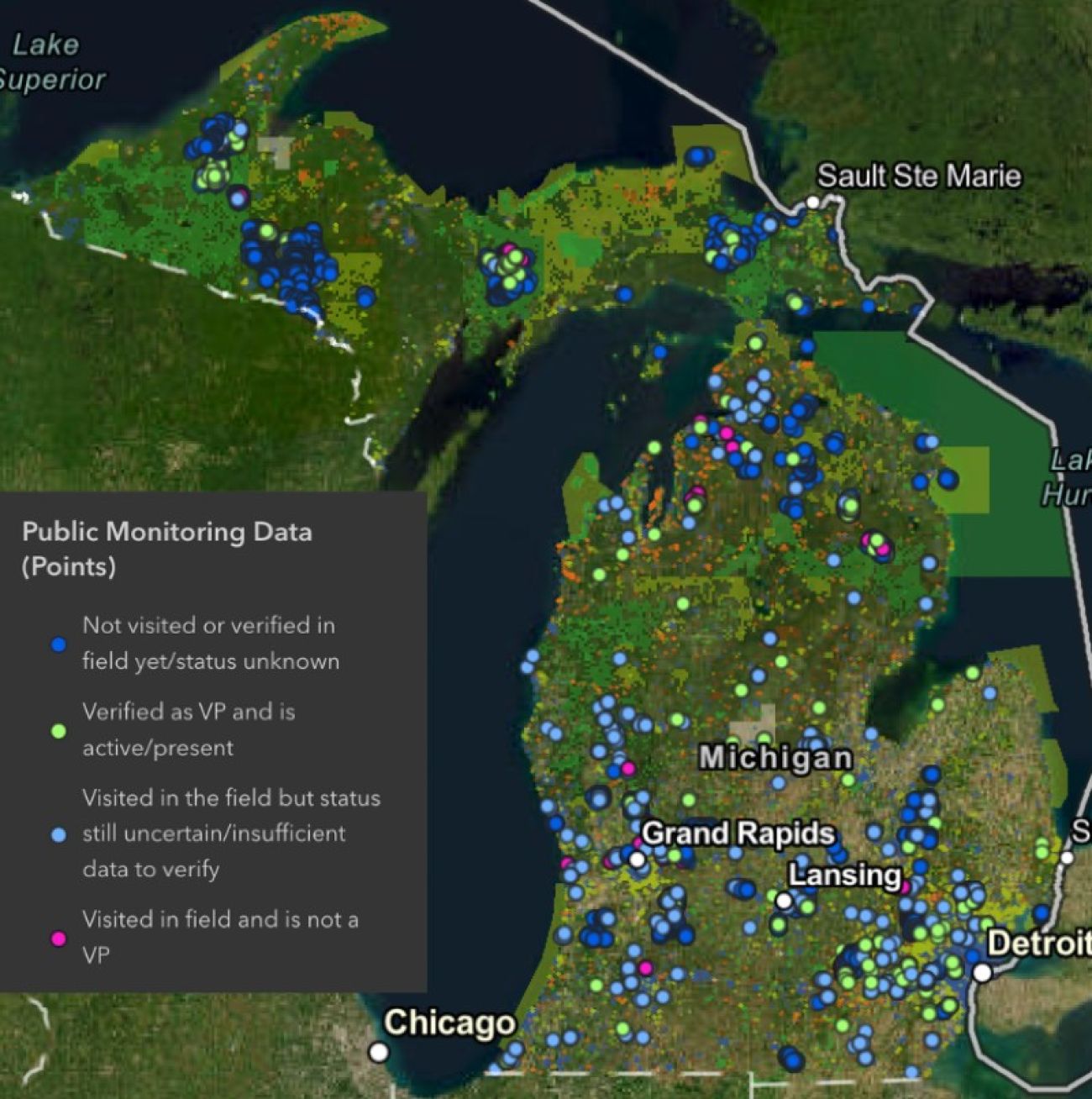Vernal pools hold hundreds of creatures. But how many exist in Michigan?

- Vernal pools may look like large puddles, but they provide critical habitat for hundreds of creatures
- We don’t know how many vernal pools there are in Michigan
- Researchers recently received a grant from NASA to continue mapping vernal pools in Michigan, New York and Wisconsin
On a chilly spring day, Adrianna Allen, a naturalist at Seven Ponds Nature Center in Dryden, led a small group of curious residents through a wooded area.
Chorus frogs, which she said “kinda sound like a finger running down a comb,” chirped nearby as Allen and her crew approached what looked like a large puddle.
“This is a very tiny little vernal pool,” Allen said.
If you’ve hiked in Michigan, you’ve likely seen them before. Vernal pools dot our state’s swampy landscape. They’re typically shallow, three feet deep or less. And they’re usually small but range in size, from a few square feet up to 2.5 acres in surface area. They provide a habitat for hundreds of critters, and food for more wildlife, but we don’t know how many of them there are in Michigan.
Researchers are working to map vernal pools and what’s in them. That data could end up serving as a way to better protect and manage the special bodies of water.
It’s tempting to think of them as small ponds, but they’re not, really.
Vernal pools can’t be connected to other waterways longterm. And they dry up at some point during the year — which means fish can’t survive in them.
Yet they’re so much more than puddles.
Take a look inside a vernal pool and you’ll find a potpourri of creatures that survive and thrive in them and provide food to bigger animals.
With the help of Henrik Crawford, age 9, and his brother, Axel Crawford, 8, Allen began dipping plastic containers into the pool’s murky water. On one of their first dips, the group found a fingernail clam, a tiny freshwater clam about the size of, well, a fingernail.
That is just one of the more than 500 animal species that have been found in vernal pools in the northeastern United States.

In Michigan, a handful of rare species utilize the temporary bodies of water. There’s Blanding’s turtle, which is considered to be declining in Michigan and is designated by the state as a species that needs to be protected. There’s the state-designated endangered smallmouth salamander and the state-designated endangered and federally designated threatened copperbelly watersnake.
Not protected, but worth noting, are fairy shrimp.
“They look like something that should be found in the ocean,” Allen said.
The tiny shrimp can only be found in vernal pools. That’s because their eggs need to dry up and freeze before they ultimately hatch in water.
RELATED:
- Michigan climate change: How fish, forests, farms, moose, ticks will change
- Broad support cited for expanding Michigan wetlands
- Video: Scientists map bottom of the Great Lakes to explore hidden habitats
Mapping the pools
It’s not known how many vernal pools there are in Michigan, but researchers are working to change that.
Michigan Technological University was recently awarded a $900,000 grant from NASA to continue work it has already begun to map vernal pools. The grant will also pay for the university to work with researchers in Wisconsin and New York to continue to map vernal pools in their states. Scientists involved in the project will use data from lasers, aerial imaging and satellite radar.
The laser data, known as LiDAR, uses laser pulses taken from an aircraft to measure indentations in the earth. Michigan Tech researchers will use LiDAR data to find small cavities that may be vernal pools.
Laura Bourgeau-Chavez, a senior research scientist at Michigan Tech Research Institute and the lead for the grant, said that, in the spring, when the leaves aren’t on the trees, aerial imagery can be used to see if there’s water in the tiny dips in the earth they’ve identified. If there are pine trees blocking their view, or if it’s later in the season when deciduous trees have leaves, they can use satellite radar data.
“It’s very sensitive to water under the canopy. You get what we call a double bounce, where most of that energy will hit the water, go forward, hit the trees, and then bounce back to the satellite,” said Bourgeau-Chavez. “And so we can verify that it has water in the spring from that and that it dries out, which it has to dry out to be a vernal pool.”

Once scientists have a list of potential vernal pools, they need to verify in person which sites really are vernal pools. To do that, they send out citizen scientists.
Michigan has been training citizen scientists to collect data and verify vernal pools for more than a decade. The Michigan Vernal Pool Partnership — a private/public partnership founded by the Michigan Natural Features Inventory, the Michigan Nature Association and the Michigan Department of Environment, Great Lakes and Energy (EGLE) — instructs members of the public on how to go to potential vernal pool locations to verify the water status, to make sure it’s not connected to other waterways, to take photos of animals and to collect various other information about the pool or indentation.
The information is then uploaded into the Michigan Vernal Pool Database, which, as of this spring, includes around 7,000 points of interest. Of those, about 15%, or about 1,000, have been visited and verified as vernal pools. About 70%, or around 4,800, are ready to be visited by citizen scientists. The remainder were visited and were either determined to not be vernal pools or more information is needed to come to a conclusion.
Why map them?
Vernal pools, while considered important, aren’t automatically protected. According to Michigan law, vernal pools may be protected if they are located within 1,000 feet of Lake St. Clair or one of the Great Lakes; located within 500 feet of an inland lake, pond, river or stream; or are less than 5 acres in size and determined by EGLE to be essential to the preservation of the state’s natural resources, among other scenarios.
The law says local governments can come up with their own wetland ordinances that could protect vernal pools, but they need to follow certain requirements. For example, a local government would need to prove that there are threatened species there, that the site supports breeding grounds for rare species, that the site provides flood mitigation or something else from a list of criteria.
Sign up for our outdoors newsletter
Bridge Michigan is investing in more coverage about Michigan's great outdoors with the launch of a newsletter in the next few weeks. Let us know what your interests are, what you want from a newsletter and be one of the first to subscribe. Sign up here.
In places where vernal pools aren’t legally protected, the Michigan Department of Natural Resources still advises best practices. The department recommends that the bottom of vernal pools not be disturbed, that efforts should be made to protect salamanders’ movement in and out of vernal pools by trying to not add any deep ruts within 100 feet of the pool, and that the tree canopy within 100 feet of the pool should not be reduced by more than 30%.
“If we want to try to better manage and protect them, we can't do that without knowing where they are,” said Yu Man Lee, a conservation scientist at Michigan Natural Features Inventory who has been working with vernal pools for more than a decade.
But Lee said the push to bring awareness to vernal pools isn’t just about finding a way to protect them, it’s also about getting people geeked about nature.
“People are excited about seeing these things, and, if we lose them, then we won't get to experience that sense of joy and awe when we see things that are really different and curious, like a fairy shrimp,” Lee said.
See what new members are saying about why they donated to Bridge Michigan:
- “In order for this information to be accurate and unbiased it must be underwritten by its readers, not by special interests.” - Larry S.
- “Not many other media sources report on the topics Bridge does.” - Susan B.
- “Your journalism is outstanding and rare these days.” - Mark S.
If you want to ensure the future of nonpartisan, nonprofit Michigan journalism, please become a member today. You, too, will be asked why you donated and maybe we'll feature your quote next time!




